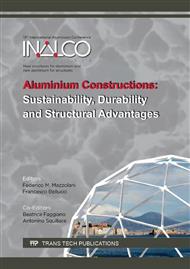p.321
p.327
p.333
p.339
p.345
p.351
p.357
p.363
p.371
Low-Cycle Fatigue Testing of a Novel Aluminum Alloy Buckling-Restrained Brace
Abstract:
Compared with steel buckling-restrained braces, aluminum alloy BRBs show excellent advantages in structures where severe corrosion effects can be expected. At the same time, in order to avoid the effect of welding discussed in the previous research, a novel Aluminum alloy Bamboo-shaped Buckling-Restrained Brace (AL-BBRB) consisting of a bamboo-shaped inner core and an outer hollow circular tube was proposed and tested herein. Parametric studies with design variables including cross-sectional sizes of slubs and length of segments were conducted. A series of low-cycle fatigue tests, containing 4 specimens, were performed to address the low-cycle fatigue behavior of AL-BBRB specimens. According to test results of all specimens, stable hysteretic curves were obtained without any local and overall buckling. Consequently, the hysteretic behavior of AL-BBRB specimens is highly concerned with the design variables. Besides, failure positions of AL-BBRB specimens often concentrates on the end of the segment, which can be exactly predicted. Based on test results of all specimens, AL-BBRB specimens show a promising future for wide application in new or retrofitted buildings/bridges where lack the excellent seismic behavior and durability.
Info:
Periodical:
Pages:
345-350
Citation:
Online since:
September 2016
Authors:
Price:
Сopyright:
© 2016 Trans Tech Publications Ltd. All Rights Reserved
Share:
Citation:


